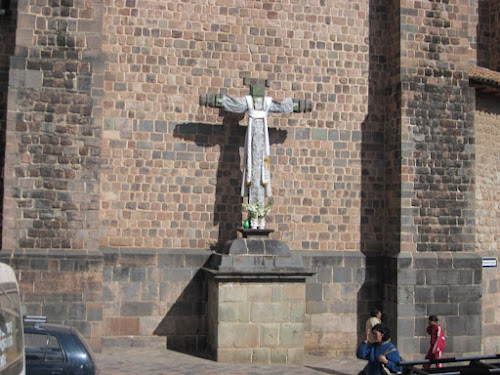Cuzco is a UNESCO world heritage city. It is filled Spanish buildings with architecture and streetscapes in a picturesque setting and other areas reflecting that it was a former capital of the Incas from the 15th century until the Spanish conquest in 1532.

 Our first visit was to Santa Catalina, a convent with a museum built over the Inca Ruins of the Acllawasi - house of the chosen women.
Our first visit was to Santa Catalina, a convent with a museum built over the Inca Ruins of the Acllawasi - house of the chosen women.

The edge on view..
 Doorway to 2nd level
Doorway to 2nd level
Thousands were recruited to wrestle the huge stones into place.
View of the city of Cusco from the top of the complex. The cathedral is the large central building.
Some of today's permanent inhabitants..
La Catedral, located in the main square, begin in 1560 and took almost 100years to complete. It was built on top of the palace of the 8th Inca, Viracocha, using red granite slabs from Sacsayhuamain. It has two auxiliary chapels on either side. The main one is El Triunfo, built on top of the main Inca armory to symbolize Spain's victory over the Incas.
The Iglesias de la Compania, a second large church also in the main square
Artisans at Museo Inca
Miss Cusco photoshoot was a our hotel much to all the guy's approval.
Di, Sandra and Elizabeth

 Our first visit was to Santa Catalina, a convent with a museum built over the Inca Ruins of the Acllawasi - house of the chosen women.
Our first visit was to Santa Catalina, a convent with a museum built over the Inca Ruins of the Acllawasi - house of the chosen women.
And the Spanish style walls surround them.
The milky way as known by the Incas, same Southern Sky and sets of stars, however the constellations have different animals interpretations.
Overall the architecture here is a good mix of Inca and Spanish...
Inca
Spanish

Sacsayhuaman ( roughly pronunced sax ay woman. ...OK then sexy woman..haha)
An impressive example of Inca military architecture only 2km NE of Cuzco. It is made up of 3 large terraces made up in a zip zag fashion. The enormous granite ramparts stretch about 300m with stones as high as 5m.The edge on view..
Here is some of the ziz zag stonework in large granite monoliths.
Oh boy - they are big..Attackers couldn't scale the walls without exposing their flank to the enemy. Doorway to 2nd level
Doorway to 2nd levelThousands were recruited to wrestle the huge stones into place.
View of the city of Cusco from the top of the complex. The cathedral is the large central building.
Some of today's permanent inhabitants..
An overview of the site
Opposite the hilltop fortress is Rodadero Hill, crowned by polished rocks and steps leading to a edifice shaped like a chair. From here the Incas presided over ceremonies.
What happened here?
The Spanish in 1536 in battle forced the Inca back to the towers and slaughtered them, however their leader Manco Inca escaped to Ollantaytambo . The condors on the Cusco coat of arms are a macabre reference to the battle's body count and immmortalising the the birds that came to feed on the dead.
Soon after their victory, the Spanish tore down many of the walls, using the site as a quarry and taking the white stones to build churches and other structures in Cusco.
The central square:Plaza de Armas Francisco Pizzarro claimed Cusco for Spain here and Tupac Amaru II, the leader of the indigenous uprising was beheaded here in 1781.
Francisco Pizzarro claimed Cusco for Spain here and Tupac Amaru II, the leader of the indigenous uprising was beheaded here in 1781.
 Francisco Pizzarro claimed Cusco for Spain here and Tupac Amaru II, the leader of the indigenous uprising was beheaded here in 1781.
Francisco Pizzarro claimed Cusco for Spain here and Tupac Amaru II, the leader of the indigenous uprising was beheaded here in 1781.
Artisans at Museo Inca
Our hotel had a central courtyard where one could eat breakfast, Colin, Karen and Di by the Fountain.
Di, Sandra and Elizabeth


































No comments:
Post a Comment